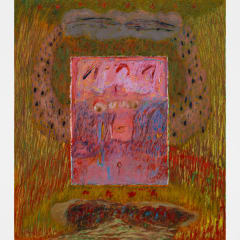Après nous le déluge Mimi Lauter
Past exhibition
Overview
Mendes Wood DM São Paulo is pleased to present Los Angeles-based artist Mimi Lauter's first solo exhibition in Brazil. Entitled Apres nous, le deluge, the exhibition brings together recent oil and soft pastel paintings on paper. The works are comprised of expansive fields of layered colors and swirling textures assembling abstracted narratives. Lauter builds these narratives through extensive research on diverse sources from mythology, literature, and the history of painting as a means to delineate the relations between image and existence.
The richly limned, almost lambent surfaces of the paintings on view nod to the visual tradition of the Les Nabis artists, such as Eduard Vuillard, Pierre Bonnard, Odilon Redon, and James Ensor. Amid abstraction and figuration, her works function as devotional paintings which historically are paintings created for the purpose of aiding in private religious worship.
Lauter believes painting itself is a tool to make people believe and proposes the belief in and devotion to painting itself, allowing the viewer to be deeply immersed in her large scale intricate works and explore her subconscious narratives. Lauter borrows the titles for her works from Rainer Maria Rilke’s Sonnets to Orpheus, such as in ‘Heavy are Mountains, Heavy the Seas’ and ‘Windy Air’ and ‘Music of Forces.’ Orpheus possessed the ability to charm all living things with his music but was ultimately torn apart by a group of passionate revelers because of the very music he created. Lauter is interested in this dichotomous relationship between life and death, and ruin and origin. The visceral forms that surge from her deeply saturated oily pastels represent both a process of vitality and regeneration. They are artificial constructions of something universally deep and true.
The phrase Apres nous, le deluge (After us, the flood) was infamously expressed by Madame de Pompadour, the lover of King Louis XV of France in the mid 18th century. The phrase has many meanings but Lauter was interested in life after the flood. A drowned world destroyed by water, an element that provides life but can also engender it. Evoking the recurrent historical trope of the flood throughout literature and art history, Lauter is interested in the flood as a paradigm of renewal amidst tension and destruction.
The richly limned, almost lambent surfaces of the paintings on view nod to the visual tradition of the Les Nabis artists, such as Eduard Vuillard, Pierre Bonnard, Odilon Redon, and James Ensor. Amid abstraction and figuration, her works function as devotional paintings which historically are paintings created for the purpose of aiding in private religious worship.
Lauter believes painting itself is a tool to make people believe and proposes the belief in and devotion to painting itself, allowing the viewer to be deeply immersed in her large scale intricate works and explore her subconscious narratives. Lauter borrows the titles for her works from Rainer Maria Rilke’s Sonnets to Orpheus, such as in ‘Heavy are Mountains, Heavy the Seas’ and ‘Windy Air’ and ‘Music of Forces.’ Orpheus possessed the ability to charm all living things with his music but was ultimately torn apart by a group of passionate revelers because of the very music he created. Lauter is interested in this dichotomous relationship between life and death, and ruin and origin. The visceral forms that surge from her deeply saturated oily pastels represent both a process of vitality and regeneration. They are artificial constructions of something universally deep and true.
The phrase Apres nous, le deluge (After us, the flood) was infamously expressed by Madame de Pompadour, the lover of King Louis XV of France in the mid 18th century. The phrase has many meanings but Lauter was interested in life after the flood. A drowned world destroyed by water, an element that provides life but can also engender it. Evoking the recurrent historical trope of the flood throughout literature and art history, Lauter is interested in the flood as a paradigm of renewal amidst tension and destruction.
Works
Installation Views





